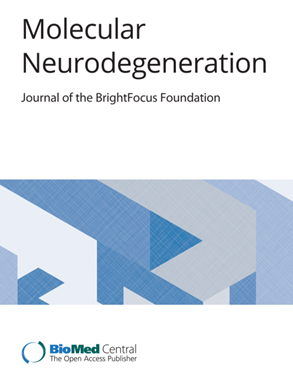非靶向血清代谢组学揭示帕金森病中氨基酸和脂质代谢的新型代谢物关联和紊乱
IF 14.9
1区 医学
Q1 NEUROSCIENCES
引用次数: 0
摘要
非靶向高分辨率代谢组学分析可同时测量数千种代谢物。基于这些数据的代谢网络有助于发现相互关联的通路中与疾病相关的扰动。在两项基于人群的研究中,我们利用非靶向代谢组学确定了与帕金森病(PD)相关的代谢紊乱。我们利用液相色谱-高分辨质谱(LC-HRMS)技术获得的血清非靶向代谢组学数据,在两个不同的病例对照人群中开展了帕金森病的全代谢组关联研究(MWAS)。我们还将研究结果与之前发表的大规模非靶向 MWAS 中 34 种与帕金森病相关的代谢物相结合,以评估外部验证。LC-HRMS 检测出4762个代谢物用于分析(HILIC:2716个代谢物;C18:2046个代谢物)。在 FDR<0.05 的条件下,我们发现了 296 个与帕金森病相关的特征,其中 134 个特征的对数折叠变化 (FC) 超过 ±0.5(228 个超过 ±0.25)。其中,104 个特征在发现和复制研究中与帕金森病独立相关,P<0.05(170 个特征 P<0.10),27 个特征与帕金森病患者的左旋多巴当量剂量相关。耐人寻味的是,经外部验证的特征包括微生物相关代谢物、对甲酚葡萄糖醛酸苷(FC=2.52,95% CI=1.67,3.81,FDR=7.8e-04)和对甲酚硫酸盐。对甲酚葡萄糖醛酸苷也与患者的运动症状有关。其他经外部验证与帕金森病相关的代谢物包括苯乙酰-L-谷氨酰胺、三尖杉酯碱、犬尿氨酸、胆绿素和泛酸。新的关联包括抗炎代谢物它康酸(FC=0.79,95% CI=0.73,0.86;FDR=2.17E-06)和半胱氨酸-硫酸盐(FC=1.56,95% CI=1.39,1.75;FDR=3.43E-11)。富集了 17 条通路,其中包括几条与氨基酸和脂质代谢相关的通路。我们的研究结果揭示了与帕金森病相关的代谢物,证实了之前的一些观察结果,包括对甲酚葡萄糖醛酸苷,并新发现了一些有趣的代谢物,如依他康酸。我们的数据还表明,帕金森病患者的氨基酸和脂质代谢紊乱以及炎症过程。本文章由计算机程序翻译,如有差异,请以英文原文为准。
Untargeted serum metabolomics reveals novel metabolite associations and disruptions in amino acid and lipid metabolism in Parkinson’s disease
Untargeted high-resolution metabolomic profiling provides simultaneous measurement of thousands of metabolites. Metabolic networks based on these data can help uncover disease-related perturbations across interconnected pathways. Identify metabolic disturbances associated with Parkinson’s disease (PD) in two population-based studies using untargeted metabolomics. We performed a metabolome-wide association study (MWAS) of PD using serum-based untargeted metabolomics data derived from liquid chromatography with high-resolution mass spectrometry (LC-HRMS) using two distinct population-based case-control populations. We also combined our results with a previous publication of 34 metabolites linked to PD in a large-scale, untargeted MWAS to assess external validation. LC-HRMS detected 4,762 metabolites for analysis (HILIC: 2716 metabolites; C18: 2046 metabolites). We identified 296 features associated with PD at FDR<0.05, 134 having a log2 fold change (FC) beyond ±0.5 (228 beyond ±0.25). Of these, 104 were independently associated with PD in both discovery and replication studies at p<0.05 (170 at p<0.10), while 27 were associated with levodopa-equivalent dose among the PD patients. Intriguingly, among the externally validated features were the microbial-related metabolites, p-cresol glucuronide (FC=2.52, 95% CI=1.67, 3.81, FDR=7.8e-04) and p-cresol sulfate. P-cresol glucuronide was also associated with motor symptoms among patients. Additional externally validated metabolites associated with PD include phenylacetyl-L-glutamine, trigonelline, kynurenine, biliverdin, and pantothenic acid. Novel associations include the anti-inflammatory metabolite itaconate (FC=0.79, 95% CI=0.73, 0.86; FDR=2.17E-06) and cysteine-S-sulfate (FC=1.56, 95% CI=1.39, 1.75; FDR=3.43E-11). Seventeen pathways were enriched, including several related to amino acid and lipid metabolism. Our results revealed PD-associated metabolites, confirming several previous observations, including for p-cresol glucuronide, and newly implicating interesting metabolites, such as itaconate. Our data also suggests metabolic disturbances in amino acid and lipid metabolism and inflammatory processes in PD.
求助全文
通过发布文献求助,成功后即可免费获取论文全文。
去求助
来源期刊

Molecular Neurodegeneration
医学-神经科学
CiteScore
23.00
自引率
4.60%
发文量
78
审稿时长
6-12 weeks
期刊介绍:
Molecular Neurodegeneration, an open-access, peer-reviewed journal, comprehensively covers neurodegeneration research at the molecular and cellular levels.
Neurodegenerative diseases, such as Alzheimer's, Parkinson's, Huntington's, and prion diseases, fall under its purview. These disorders, often linked to advanced aging and characterized by varying degrees of dementia, pose a significant public health concern with the growing aging population. Recent strides in understanding the molecular and cellular mechanisms of these neurodegenerative disorders offer valuable insights into their pathogenesis.
 求助内容:
求助内容: 应助结果提醒方式:
应助结果提醒方式:


